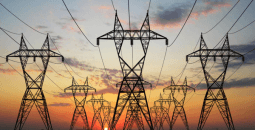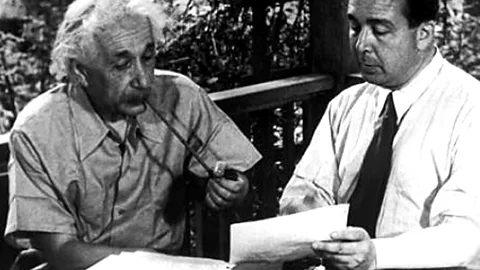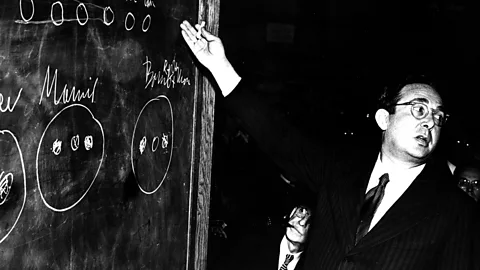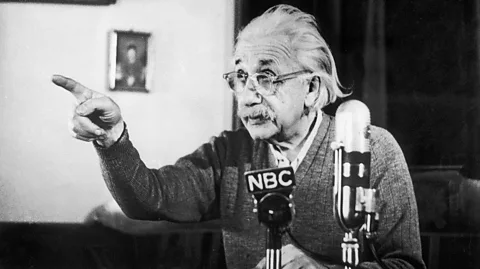

ON 2 August 1939, Albert Einstein wrote to the US President Franklin D Roosevelt. His letter would result in the Manhattan Project, and one of history’s most significant – and destructive – inventions.
The dramatic account of the lethal harnessing of atomic power told in the 2023 blockbuster film Oppenheimer might have been nothing more than science fiction had a two-page letter, dated 2 August 1939, never been written.
“Recent work in nuclear physics made it probable that uranium may be turned into a new and important source of energy,” reads a typed letter to US President Franklin D Roosevelt signed by hand by the esteemed physicist Albert Einstein. This energy, he continues, could be used “for the construction of extremely powerful bombs”.
Expressing suspicion at Germany’s decision to halt uranium sales in occupied Czechoslovakia, the letter was the impetus for a $2 billion top-secret research programme, the “Manhattan Project”: a race to beat Germany in the development of atomic weapons. The three-year project, led by physicist Robert Oppenheimer, would propel the US into the nuclear age and lead to one of history’s most significant – and destructive – inventions: the atomic bomb.
 Christie’s Images Ltd
Christie’s Images LtdOn 10 September 2024, Einstein’s consequential and carefully worded letter will be auctioned at Christie’s New York, and is expected to fetch in excess of $4m. Two versions of the letter were drafted: a shorter version, being auctioned by Christie’s, and a more detailed version, delivered to the White House by hand, and now in the permanent collection of the Franklin D Roosevelt Library in New York.
“In so many ways, this letter marks a key inflection point in the history of science, technology and humanity,” Peter Klarnet, senior specialist for Americana, books and manuscripts at Christie’s, tells the BBC. “This is really the first time that the United States government becomes directly financially involved in major scientific research,” he adds. “The letter set the ball rolling to allow the United States to take full advantage of the technological transformations that were taking place.”
Dr Bryn Willcock, the programme director for the Department of Politics, Philosophy, and International Relations at Swansea University and a lecturer and researcher in American and Nuclear History, agrees. “Most historical accounts of the origins of the bomb begin with a discussion of the letter,” he tells the BBC. “The letter’s contents were key to getting direct action from President Roosevelt,” he says, emphasising that “the Atomic Heritage Foundation goes as far as to describe the letter… as ‘vital’ in pushing Roosevelt into undertaking atomic research.”
The award-winning film Oppenheimer, which is based on the story of the Manhattan Project and references the letter in a scene between Oppenheimer and physicist Ernest Lawrence, is expected to fuel additional interest in the auction. “This [letter] is something that has been part of the popular culture from 1945 onwards, so it already has a firm place, but I think the Oppenheimer movie brought it now to a new generation,” says Klarnet.

Klarnet describes Einstein as “a mythical character” in popular culture. He certainly has that quality in Oppenheimer, lurking at the film’s periphery, like a cameo role we eagerly await, his identity only revealed when his hat flies off and exposes that famous shock of white hair.
Einstein distanced himself from the project and always insisted that his part in the release of atomic energy was “quite indirect”
Though Einstein’s equation E = mc2 explained the energy released in a nuclear reaction and paved the way for its sinister application, his role in the forging of an atomic bomb is perhaps overstated in the film. The poignant exchange between Oppenheimer and Einstein in the closing scene (Oppenheimer: “When I came to you with those calculations, we thought we might start a chain reaction that would destroy the entire world…”) is “nonsense”, says Klarnet.
Einstein, whose left-leaning views and German heritage surrounded him with suspicion, “did not have the security clearance for that”, he says. In fact, the avowed pacifist distanced himself from the project and always insisted that his part in the release of atomic energy was “quite indirect“.
If anyone was the instigator it was Leo Szilard, a former student of Einstein’s. The letter, with Szilard’s pencilled note “Original not sent!”, would remain in Szilard’s possession until his death in 1964. Both the German-born Einstein and the Hungarian-born Szilard were Jews who had fled to the US following the rise of Nazism and understood, better than anybody, the threat that Germany posed.
 Getty Images
Getty ImagesThe letter was Szilard’s idea but he was dogged in his pursuit of Einstein to author and sign it. Einstein conferred considerable authority and, on winning the Nobel Prize in 1921, became “the personification of modern science”, says Klarnet. “He has an influence that no one else does. Other people apparently did try to warn Roosevelt about what was going on in the months leading up to this, but all of a sudden, you’re walking in the door with a letter from Albert Einstein saying that you should do this – that makes an impression.”
On 16 July 1945, security-cleared spectators shielded their eyes with goggles as a prototype of the bomb, known as “the gadget”, was successfully detonated in a New Mexico desert. The result was met with both triumph and trepidation. On this day, US President Harry S Truman wrote in his diary: “we have discovered the most terrible bomb in the history of the world”.
Germany, but not Japan, had surrendered and it was thought that attacking the Japanese ports of Hiroshima and Nagasaki with a terrifying and unprecedented power would hasten the end of the war. Though Szilard launched a petition a day after the bomb tests recommending that Japan be invited to surrender before taking such drastic action, it did not reach the authorities in time.
On 6 August, a bomb codenamed “Little Boy” was dropped on Hiroshima. “Fat Man” was detonated in Nagasaki on 9 August. An estimated 200,000 people were killed or injured, with many more perishing years later due to the side effects of radiation. To date, these are the only instances of nuclear weapons being directly employed in conflict.
Whether the Manhattan Project would have existed without Einstein’s letter is hard to say. Willcock notes that Britain was already “trying hard to push America into supporting greater research” and describes the British-led MAUD Report (1941), a study of the feasibility of nuclear weapons, as “crucial to pushing American research development”. Yet Einstein’s letter can only have accelerated the process. Without it, there may have been a delay which, says Willcock, “would of course have likely meant that the bomb would not be ready for use by the summer of 1945.”

Einstein, for his part, bitterly regretted the violence and chaos that his 1939 letter had unleashed. In 1946, he co-founded the Emergency Committee of Atomic Scientists to publicise the dangers of nuclear war and to propose a pathway to world peace. In an article for Newsweek Magazine in 1947, titled Einstein, The Man Who Started it All, he stated: “Had I known that the Germans would not succeed in developing an atomic bomb, I would have done nothing for the bomb.” Today, despite having the technological know-how, Germany still does not own nuclear weapons.
Einstein would devote the remainder of his life to campaigning for nuclear disarmament. Speaking to the Nobel Prize-winning chemist Linus Pauling in 1954, he described the letter to Roosevelt as the “one great mistake in my life“.
The atomic bomb radically altered the landscape of warfare and triggered an East-West arms race that continues to shape international relations. With nine nations now in possession of nuclear weapons, much of the jeopardy we feel can be dated back to that letter. “It’s still a very relevant issue today. It’s a shadow that hangs over humanity,” says Klarnet. “This letter is a reminder of where our modern world comes from and a stark reminder of how we got here.”
In July 1955, the name that signed off the seminal 1939 letter to Roosevelt would feature posthumously in the title of the Russell-Einstein Manifesto, an emotively worded resolution against nuclear war initiated by philosopher Bertrand Russell and endorsed by Einstein just a week before his death. “We appeal, as human beings, to human beings,” reads part of the text. “Remember your humanity and forget the rest. If you do so, the way lies open to a new paradise; if you cannot, there lies before you the risk of universal death.” – bbc.com